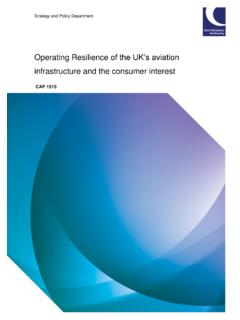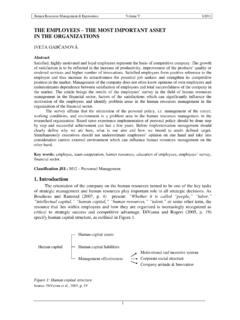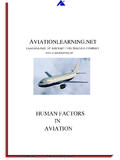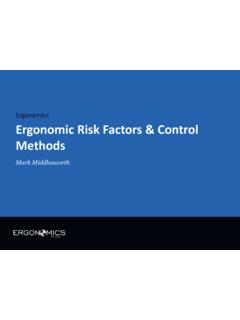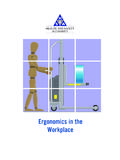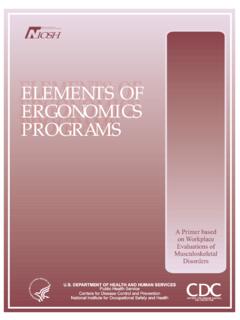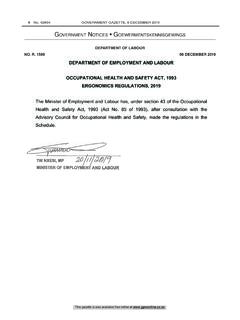Transcription of CAP 719 Fundamental Human Factors Concepts
1 CAP 719 Fundamental Human Factors Concepts (previously ICAO Digest No. 1) Regulation GroupImportant NoteThis document was previously published by ICAO as Circular number 216-AN/131. Human FactorsDigest No. 1 Fundamental Human Factors Concepts . The agreement of ICAO to enable this flightsafety information to be made available in this format, is gratefully acknowledged. The latest version ofthis document can be found at 719 Fundamental Human Factors Concepts (previously ICAO Digest No. 1)Safety Regulation Group15 February 2002 CAP 719 Fundamental Human Factors Concepts Civil Aviation Authority 2002 ISBN 0 86039 844 7 First Edition 15 February 2002 Enquiries regarding the content of this publication should be addressed to: Human Factors , Operating Standards Division, Safety Regulation Group, Civil Aviation Authority,Aviation House, Gatwick Airport South, West Sussex, RH6 latest version of this document is available in electronic format at , where you mayalso register for e-mail notification of copies and amendment services are available from: Documedia Solutions Ltd.
2 , 37 WindsorStreet, Cheltenham, Glos., GL52 2DG. CAP 719 Fundamental Human Factors ConceptsChapterPageDate ChapterPageDate ChapterPageDate Page iii iii 15 February 2002 iv 15 February 2002 v 15 February 2002 vi 15 February 2002 vii 15 February 2002 viii 15 February 2002 Chapter 1 1 15 February 2002 Chapter 1 2 15 February 2002 Chapter 1 3 15 February 2002 Chapter 1 4 15 February 2002 Chapter 1 5 15 February 2002 Chapter 2 1 15 February 2002 Chapter 2 2 15 February 2002 Chapter 2 3 15 February 2002 Chapter 2
3 4 15 February 2002 Chapter 2 5 15 February 2002 Chapter 3 1 15 February 2002 Chapter 3 2 15 February 2002 Chapter 3 3 15 February 2002 Chapter 3 4 15 February 2002 Chapter 3 5 15 February 2002 Chapter 3 6 15 February 2002 Chapter 3 7 15 February 2002 Chapter 3 8 15 February 2002 Chapter 3 9 15 February 2002 Chapter 3 10 15 February 2002 Chapter 3 11 15 February 2002 Chapter 4 1 15 February 2002 Chapter 4 2 15 February 2002 Chapter 4 3 15 February 2002 Appendix A 1 15 February 2002 Appendix A 2 15 February 2002 Appendix A 3 15 February 2002 Appendix A 4 15 February 2002 Appendix A 5 15 February 200215 February 2002 List of Effective PagesCAP 719 Fundamental Human Factors Concepts Page ivList of Effective PagesiiiForewordviIntroductionviiChapter 1 The Meaning of Human FactorsIntroduction 1 The disciplines of Human Factors 1 Human Factors and Ergonomics 2A conceptual Model of Human Factors 3 Chapter 2 The Industry Need for Human FactorsOverview 1 Effectiveness of the System 1 Well-being of Crew Members 3 Chapter 3 Human Factors Applications in Flight OperationsControl of Human Error 1 Plain Talk 2 Training and Evaluation 2 Human Factors Training 4 Motivation 8 Flight Documentation 9 Flight Deck Design 9 Cabin Design 10 Visual Performance and Collision Avoidance 11 Chapter 4 Education and ExpertiseOverview 1 Levels of Expertise Required 1 Courses Available 2 Information Available 3 Contents15 February 2002 CAP 719 Fundamental Human Factors Concepts Page vAppendix AReferencesJournals
4 1 Bulletins 1 Incident Reporting Systems 1 Books Recommended Reading 1 Books Reference library 2 Reference Articles and Papers 3 Audio Visual Training Products 4 French Language References 4 Spanish Language References 5 Russian Language References 515 February 2002 CAP 719 Fundamental Human Factors Concepts Page safety is the major objective of the International Civil Aviation progress has been made, but additional improvements are needed andcan be achieved. It has long been known that some three out of four accidents resultfrom less than optimum Human performance, indicating that any advance in this fieldcan be expected to have a significant impact on the improvement of flight safety. was recognized by the ICAO Assembly, which in 1986 adopted Resolution A26-9 on Flight Safety and Human Factors .
5 As a follow-up to the Assembly Resolution, theAir Navigation Commission formulated the following objective for the task: To improve safety in aviation by making States more aware andresponsive to the importance of Human Factors in civil aviation operationsthrough the provision of practical Human Factors material and measuresdeveloped on the basis of experience in States. of the methods chosen to implement Assembly Resolution A26-9 is thepublication of a series of digests which will address various aspects of Human Factorsand their impact on flight safety. These digests are intended primarily for use byStates, to increase the awareness of their personnel of the influence of humanperformance on safety. The ICAO Secretariat will endeavour to assist Statesrequesting additional information on the documentation available from varioussources, on research undertaken by other States and on any assistance available frominstitutions or individuals.
6 Digests are aimed at the managers of both civil aviation administrations and theairline industry, including airline operational and training managers. Regulatory bodies,safety and investigation agencies and training establishments should also find themuseful, as will senior and middle non-operational airline management, in their questfor effectiveness. 15 February 2002 CAP 719 Fundamental Human Factors Concepts Page behaviour and performance are cited as causal Factors in the majority ofaircraft accidents. If the accident rate is to be decreased, Human Factors must bebetter understood and the knowledge more broadly applied. The expansion of HumanFactors awareness presents the international aviation community with the singlemost significant opportunity to make aviation both safer and more efficient. Thepurpose of this digest is to present an overview of the various components whichconstitute Human Factors and to clarify its meaning.
7 Since humans began to make tools, thousands of years ago, the application ofelementary ergonomics has improved work efficiency. But it is only during the lasthundred years that the modern evolution of ergonomics or Human Factors has begun. need during the First World War to optimize factory production and to assignthousands of recruits more effectively to military duties, and the fact that during theSecond World War sophisticated equipment was surpassing Human capability tooperate it with maximum effectiveness provided further stimulus to Human Factorsprogress. Selection and training of staff, too, began to be approached morescientifically. institutionalization of Human Factors , or ergonomics, occurred with the foundingof several organizations such as the Ergonomics Research Society in 1949, theHuman Factors Society in 1957 and the International Ergonomics Association (IEA) in1959. recognition that basic Human Factors education was needed throughout theindustry led to various approaches to formal training in different countries.
8 Thisrecognition was tragically emphasized when, at Tenerife in 1977, two aircraft collided,with a loss of 583 lives, a disaster resulting almost entirely from a series ofdeficiencies in the application of Human Factors . 1976 agreement between the United States Federal Aviation Administration(FAA) and the National Aeronautics and Space Administration (NASA) to establish avoluntary, non- punitive, confidential Aviation Safety Reporting System (ASRS)constituted official recognition that adequate information for analysis of humanbehaviour and errors in Human performance is best obtained by eliminating the threatof punitive action against the person making the report. By 1989, over 110 000 reportshad been received by ASRS, the system had issued nearly 1 000 alert bulletins andover 1 500 special studies had been made. Similar schemes were later set up in theUnited Kingdom (CHIRP), Canada (CASRP) and Australia (CAIR).
9 Is not the purpose of this digest to determine if Human Factors was adequatelyapplied in aviation in the past, but rather to present what can usefully be done toensure adequate progress in the future. Nor is it intended that the digest be used asa substitute for properly constructed courses or books based on years of , the purpose of the digest is to provide an introduction to the subject and toencourage the use of available sources of education and training. 15 February 2002 CAP 719 Fundamental Human Factors Concepts Page scope of this digest includes: a) the meaning and definition of Human Factors , a conceptual model of it, andclarification of common misconceptions; b) the industry need for Human Factors ; c) the application of Human Factors in flight operations; and d) the levels of expertise required and the formal approaches to education. digest was produced with the assistance of the ICAO Flight Safety and HumanFactors (HF) Study Group.
10 The major references used in its preparation are the bookHuman Factors in Flight, by Frank Hawkins, 1987, while parts of the conceptualapproach, especially in Chapter 1, are based upon the ideas of Professor ElwynEdwards as most recently published in the book Human Factors in Aviation, byWiener and Nagel. 15 February 2002 CAP 719 Fundamental Human Factors Concepts Chapter 1 Page 1 Chapter 1 The Meaning of Human Factors1 Introduction Factors as a term has to be clearly defined because when these words areused in the vernacular they are often applied to any factor related to humans. Thehuman element is the most flexible, adaptable and valuable part of the aviationsystem, but it is also the most vulnerable to influences which can adversely affect itsperformance. Throughout the years, some three out of four accidents have resultedfrom less than optimum Human performance. This has commonly been classified as pilot error.




